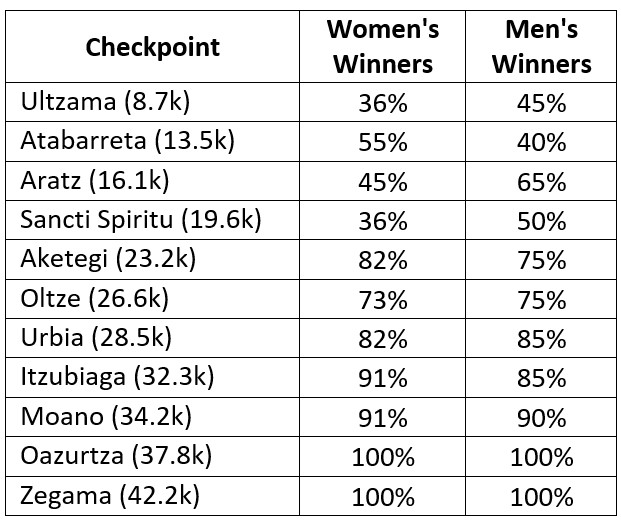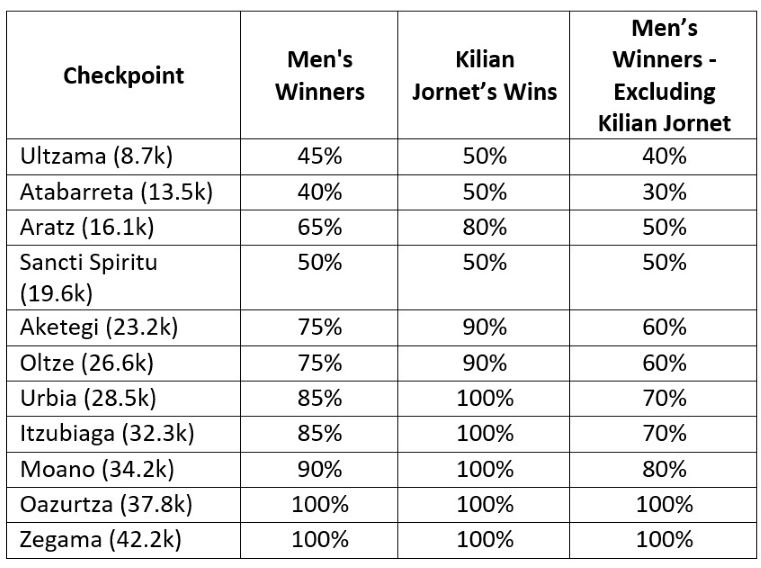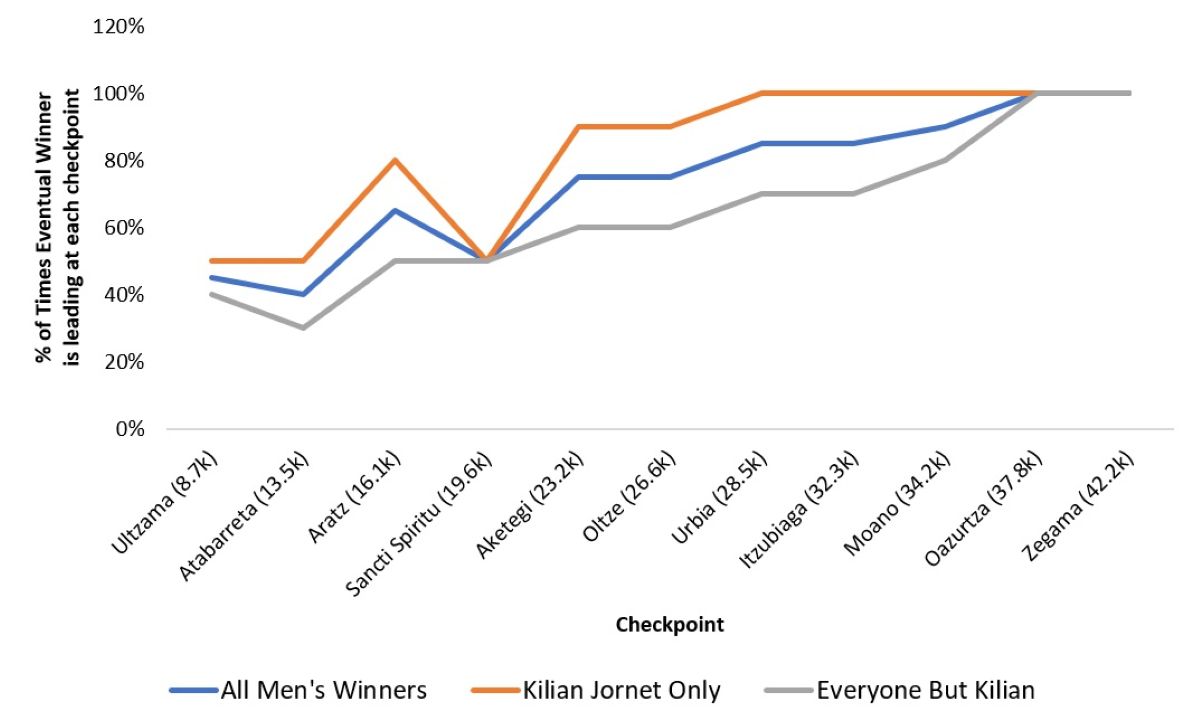Of the two winners of the 2024 Zegama-Aizkorri Marathon, one took the lead after 13 kilometers and pulled away from the rest of the lead pack in the second half of the race, while the other was already leading by the first checkpoint. Was either race strategy, from Norway’s Sylvia Nordskar and Spain’s Kilian Jornet, respectively, more typical for this iconic event?
Established, competitive races offer a special opportunity to study racing strategy. A race that has over a decade’s worth of competitive results in a deep field lets us dig into whether top runners tend to lead from the start or run with a pack. We can look at whether they secure their lead on a particular climb, descent, or mileage marker. iRunFar published a similar analysis in 2022 for UTMB. This time, thanks to a race organization that generously shared years of race splits with us, we’re doing something similar for this marathon-distance trail race.
About the Zegama Marathon
Held annually in May in the Basque Autonomous Region, this 42-kilometer trail race involves over 2,700 meters (about 8,600 feet) of elevation on technical terrain. The course departs from the town of Zegama, climbs to the Otzaurte mountain, reaches its highest point at Aketegi, and returns to Zegama for the finish. Runners have eight hours to cover the distance and, as of publication:
- Nienke Brinkman (The Netherlands) holds the women’s course record of 4:16:43, set in 2022, and
- Kilian Jornet holds the men’s course record of 3:36:40, also set in 2022.
Methodology
To determine how the top of the field is dispersed at each checkpoint over the years, I created a master spreadsheet from 11 years’ worth of race splits, kindly provided to me by the race directors. Because Kilian Jornet has won the race 11 times in its 20-year history, I also analyzed splits for the top of the men’s field, going back to 2002. Because the format of the Excel documents varied over the years, I normalized the data to the best of my ability, as someone who hasn’t been on the Zegama course personally. The names and orders of the checkpoints indicate there were likely modest changes to the route or at least the timing points from one year to the next.
The greatest challenge I faced was that several years’ worth of splits did not separate racers by gender. I therefore had to identify the top women’s finishers by cross-referencing the splits with other sources with the overall race results. There is a chance I missed women who were running at the front of the field early in the race in one of those years, who later dropped from the race or slowed dramatically and finished out of the top 20. Please treat this analysis as you would a copy of Shakespeare’s works typed up for you by a monkey: affordable entertainment that shouldn’t inform your race strategy.
General Observations on Zegama Strategy
Based on the splits I reviewed, the Zegama winner has consistently taken the lead by the Oazurtza checkpoint, running at the front for at least the final 4k of the race. It’s common for the top men and women to be running together in the early kilometers of the race, with the eventual winners almost always assuming the lead by the halfway point.
If there was a “turning point” in the race, the data suggests it’s the long climb and rocky traverse between the Sancti Spiritu (19.6k) and Aketegi (23.2k) checkpoints (1). For example, the women’s winners from 2012 onward were leading at Sancti Spiritu 36% of the time, but 82% of the eventual women’s winners were in the lead by Aketegi, less than 4k — but plenty of climbing — later. Interestingly, there is a slight decrease in the percentage of eventual winners who are leading at Sancti Spiritu, compared to the previous checkpoint. It’s possible the best performers “save themselves” for the climb up to Aketegi by giving up a few seconds to their competitors as they approach the climb.
Table and Chart Showing How Frequently the Winner is In the Lead by Checkpoint
Nuances of the Men’s Race
As mentioned above, Jornet has won the men’s race 11 times. Does this skew the men’s results, that roughly half of all wins were claimed by the same individual? To assess that, I pulled splits for the top male finishers for every edition of the race where I had that data (2). As you’ll see in the table below, Jornet tends to establish his lead earlier than the other men’s winners, when they’re considered as a group.
Table and Chart Showing How Often Male Winner is In the Lead by Checkpoint
The table and chart above might be misleading, though. While Jornet isn’t always the first runner through the earliest checkpoints in years when he wins, he isn’t far behind. Since 2014, the largest gap Jornet had to make up in any year he won was Marc Lauenstein’s (Switzerland) nine-second lead at Sancti Spiritu in 2016. Jornet ultimately finished a little over nine minutes ahead of Lauenstein, who held onto second place.
This raises a fascinating shortcoming of relying on data to appreciate an elite runner’s racing strategy: Should I describe Jornet’s style as enjoying the dynamics of racing with fellow elites for as long as they can keep up with him? Or does he race the way a cat plays with a mouse? In this sense, permitting and then eliminating a gap of up to nine seconds can’t tell the full story.
Time Gaps Between Jornet and His Top Competitor Per Checkpoint

The chart above shows that the time gaps between Jornet and either the first runner through a checkpoint or the next runner after Jornet through a checkpoint for his five most recent wins has ranged from another runner having a nine-second lead on Jornet to Jornet being 731 seconds (12 minutes, 11 seconds) ahead.
Nuances of the Women’s Race
Women accounted for 15% of the field at Zegama in 2024. With fewer entrants in the women’s race, the top female runners have relatively fewer opportunities to work off of each other in packs, although they can run with and against the men to push themselves, as Nikki Kimball (U.S.) likely did when she beat Ian Sharman (U.K.) by one second in 2012.
One exciting offshoot of this is a greater opportunity for come-from-behind wins in the women’s race. In notable contrast to Jornet’s tendency to stay at or within seconds of the front for the full duration of the race, the women’s race at Zegama has included some inspiring results where the eventual winners proved they could control the race from any position in the field, picking their pace and moments on their own terms.
For example, when Maite Maiora (Spain) set a then-course record in 2017, she let Silvia Rampazzo (Italy) take an early lead, with Maiora herself running in fourth at the first checkpoint. Maiora was up to 35 seconds back of Rampazzo in the early kilometers of the race, before catching up and establishing an 89-second lead on the climb to Aketegi just over halfway through the race. Maiora continued to steadily extend her lead, ultimately finishing almost three minutes ahead of Rampazzo.

Maite Maiora making her way through the Zegama Marathon’s spirited fans on her way to the win. Photo: iRunFar/Bryon Powell
Yngvild Kaspersen (Norway) had an even more striking come-from-behind win in 2016. Kaspersen was as far back as fifth place in the early kilometers of the race. When Megan Kimmel (U.S.) took the lead on Aizkorri, Kaspersen was over seven minutes back. Kaspersen was relentless, though. In the final 19k of the race, Kaspersen ate up the six-minute lead Kimmel held at Aketegi and then gapped Kimmel by nearly nine minutes at the finish line.
The chart below plots the time gap between Kaspersen and the first runner through a checkpoint or the next runner after Kaspersen through a checkpoint. The negative values indicate how far Kaspersen was behind the leading runner, but the line illustrates how steadily Kaspersen caught up and then pulled ahead.
Time Gaps Between Yngvild Kaspersen and Nearest Competitor Per Checkpoint

The chart above shows that while some race winners stay within contact of the front of the field at all points in a race, others, such as Kaspersen, have had success eating up a competitor’s lead and then building one of their own.
Closing Thoughts
I generally aspire to write these columns in a way that leaves you with food for thought on a long run. Splits for the front of the field at the Zegama Marathon do offer some things worth considering:
- It’s very common for race winners to take the pace out hot. They’re frequently leading from the outset, or running close to the race leaders.
- A sustained climb in the middle of the race becomes an opportunity for the best runners to distinguish themselves, moving up in the field and/or extending their lead.
- While Zegama, which has been around since 2002, predates the trail running boom — at least in North America — it’s still challenging to analyze broad trends in its racing strategy because so many of the men’s wins can be attributed to a single person.
- No one wins Zegama by accident — all of these runners are remarkable.
- If the rest of us want to be more like these Zegama winners, we should be comfortable running hard from the beginning of a race, and be able to ascend fast on technical terrain.
Basically, we can spend more time thinking about how these folks race Zegama than they’ll actually spend racing it.

Manuel Merillas on his way to winning the 2023 Zegama Marathon. Photo: Golden Trail Series|Zegama-Aizkorri Marathon|Martina Valmassoi
Call for Comments
- Do you think these findings are unique to Zegama or extend to other trail races of comparable distances?
- If you’ve run Zegama, care to share your experience?
Notes
- The Aketegi checkpoint is after the Aizkorri summit. I do not see it referenced in all course profiles or race splits.
- The Zegama Marathon was canceled in 2020 and 2021, and I only had general results for 2011.






